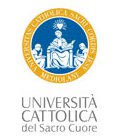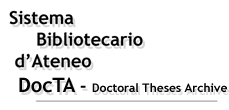|
|
DocTA - Doctoral Theses Archive >
Tesi di dottorato >
SCUOLA DI DOTTORATO IN STUDI UMANISTICI. TRADIZIONE E CONTEMPORANEITA' >
Citazione:
Utilizza queste indicazioni per citare o creare un link a questo documento.
|
Fiaccadori, Chiara. "FRANCESCO SCARAMUZZA (SISSA, 1803 - PARMA, 1886)", Università Cattolica del Sacro Cuore, XXVIII ciclo, a.a. 2014/15, Milano, [http://hdl.handle.net/10280/10488].
|
| Titolo: | FRANCESCO SCARAMUZZA (SISSA, 1803 - PARMA, 1886) |
| Autore/i: | FIACCADORI, CHIARA |
| Tutor: | TEDESCHI, FRANCESCO |
| Coordinatore: | BEARZOT, CINZIA SUSANNA |
| Lingua: | ITA |
| Abstract in italiano della tesi: | Il presente studio si propone di ricostruire, in una dimensione monografica, la figura di Francesco Scaramuzza, personalità artistica prolifica che ha determinato nella prima metà dell’Ottocento il nuovo corso della pittura parmense. Interprete e portatore di un Romanticismo atipico, fu debitore, a suo modo, tanto della lezione dei Nazareni quanto, più tardi, della svolta lombarda verso i temi contemporanei, senza mai trascurare l’amata impronta correggesca. L’artista attraversa tre distinti momenti di committenza, dal governo restaurato di Maria Luigia d’Asburgo, dopo la parentesi napoleonica, all’infelice intervallo borbonico, presto sfociato nell’annessione al regno Sardo di Vittorio Emanuele II. Sotto la sovrana austriaca giunge all’apice della carriera, subendo, però, una battuta d’arresto con i Borbone a causa delle sue note simpatie libertarie. Trova una conferma nel nuovo governo unitario, il quale gli affida il compito di illustrare la Divina Commedia, la sua opera più nota e più riuscita, che segnerà, dopo diciassette anni di strenuo lavoro, il punto di arrivo della sua carriera d’artista. |
| Abstract in inglese: | This study aims to reconstruct, in a monographic dimension, the profile of Francesco Scaramuzza, a prolific artist who determined the new course of painting in Parma in the first half of the 19th century. Interpreter and bearer of an atypical Romanticism, in his artistic development he was inspired by the lessons of the Nazarenes as much as by the Lombard interest in contemporary subjects, without neglecting the beloved imprint of Correggio’s style. Throughout his career he went through three different patronages, from the restored regime of Marie Louise of Hapsburg, after the Napoleonic period, to the unhappy Bourbon interlude, ended quickly with the annexation to the reign of Vittorio Emanuele II. Under the Austrian sovereign he reached the peak of his career, suffering, however, a setback under the Bourbon government because of his well-known libertarian sympathies. His value was recognized eventually by the establishment of the united Italy, who entrusted him to illustrate the Divine Comedy, his most famous and successful work, which will mark, after seventeen years of strenuous work, the conclusion of his career as an artist. |
| Data di discussione: | 8-mar-2016 |
| URI: | http://hdl.handle.net/10280/10488 |
| È visualizzato nelle collezioni: | SCUOLA DI DOTTORATO IN STUDI UMANISTICI. TRADIZIONE E CONTEMPORANEITA'
FACOLTA' DI LETTERE E FILOSOFIA
|
File in questo documento:
| File |
Dimensioni | Formato | Accessibilità |
|---|
| tesiphd_completa_Fiaccadori.pdf | 9,14 MB | Adobe PDF | non consultabile
|
|
Accesso e utilizzo dei contenuti di DocTA
|



